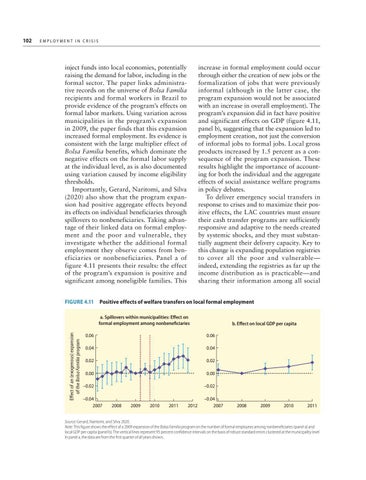102 E m p l o y m e n t
in Crisis
increase in formal employment could occur through either the creation of new jobs or the formalization of jobs that were previously informal (although in the latter case, the program expansion would not be associated with an increase in overall employment). The program’s expansion did in fact have positive and significant effects on GDP (figure 4.11, panel b), suggesting that the expansion led to employment creation, not just the conversion of informal jobs to formal jobs. Local gross products increased by 1.5 percent as a consequence of the program expansion. These results highlight the importance of accounting for both the individual and the aggregate effects of social assistance welfare programs in policy debates. To deliver emergency social transfers in response to crises and to maximize their positive effects, the LAC countries must ensure their cash transfer programs are sufficiently responsive and adaptive to the needs created by systemic shocks, and they must substantially augment their delivery capacity. Key to this change is expanding population registries to cover all the poor and vulnerable— indeed, extending the registries as far up the income distribution as is practicable—and sharing their information among all social
inject funds into local economies, potentially raising the demand for labor, including in the formal sector. The paper links administrative records on the universe of Bolsa Familia recipients and formal workers in Brazil to provide evidence of the program’s effects on formal labor markets. Using variation across municipalities in the program’s expansion in 2009, the paper finds that this expansion increased formal employment. Its evidence is consistent with the large multiplier effect of Bolsa Familia benefits, which dominate the negative effects on the formal labor supply at the individual level, as is also documented using variation caused by income eligibility thresholds. Importantly, Gerard, Naritomi, and Silva (2020) also show that the program expansion had positive aggregate effects beyond its effects on individual beneficiaries through spillovers to nonbeneficiaries. Taking advantage of their linked data on formal employment and the poor and vulnerable, they investigate whether the additional formal employment they observe comes from beneficiaries or nonbeneficiaries. Panel a of figure 4.11 presents their results: the effect of the program’s expansion is positive and significant among noneligible families. This
FIGURE 4.11 Positive effects of welfare transfers on local formal employment
Effect of an (exogenous) expansion of the Bolsa Familia program
a. Spillovers within municipalities: Effect on formal employment among nonbeneficiaries
b. Effect on local GDP per capita
0.06
0.06
0.04
0.04
0.02
0.02
0.00
0.00
–0.02
–0.02
–0.04 2007
2008
2009
2010
2011
2012
–0.04 2007
2008
2009
2010
2011
Source: Gerard, Naritomi, and Silva 2020. Note: This figure shows the effect of a 2009 expansion of the Bolsa Familia program on the number of formal employees among nonbeneficiaries (panel a) and local GDP per capita (panel b). The vertical lines represent 95 percent confidence intervals on the basis of robust standard errors clustered at the municipality level In panel a, the data are from the first quarter of all years shown.

